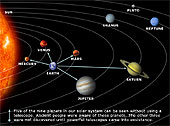
Planets are bodies that orbit around the sun (or other stars).
The Earth is a planet. There are 8 other planets in our solar system:
Mercury, Venus, Mars, Jupiter, Saturn, Uranus, Neptune, and Pluto.
Earth is between Venus and Mars; it is the third planet from the sun.
Often in the night sky, there appear to be stars that seem bigger or
shine more brightly than the others. The most obvious difference between
these "bright stars" is that they are not fixed points of light
like actual stars are but they change position in the sky from night to
night. These "bright stars" are actually planets in our
Solar System reflecting the Sun's light. The word planet means "wanderer".
There are five planets that are frequently visible in the night sky.
They are the five planets that are closest to Earth: Mercury, Venus, Mars,
Jupiter and Saturn.
Venus:
Venus is the second planet from the Sun, between Mercury and Earth. Because
of its brightness and the way it moves in the sky, Venus was thought to
be a very special star. Many cultures have observed Venus in the sky and
have used its appearance and disappearance to keep track of time. Because
of its nearness to Earth and the Sun, Venus is the most brilliant and
the most frequently observed planet. Venus appears in the western
sky after sunset or in the eastern sky before sunrise.
1
of 1
|

|

|

|

|
G A L L E R Y |

Take a closer look at our solar system. [enlarge] |
|
| M
O R E |
| Learn
about how the Aztecs used the helical rising of Venus to keep
time. |
|
| M
O R E |

Learn more about the planets
at the Adler Planetarium and Astronomy Museum. |
|
|